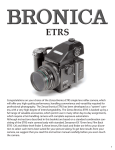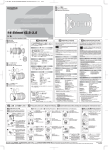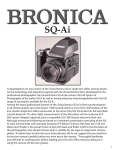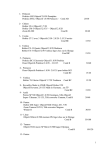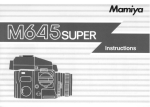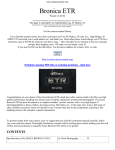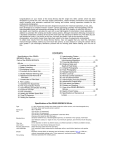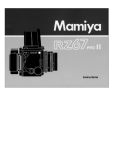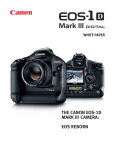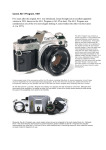Download Zenza Bronica GS-1 Instruction manual
Transcript
SQ-B Thank you for purchasing the Bronica SQ-B camera kit. Based on the technology and experience acquired through the evolution of the Bronica SQ Series, the SQ-B is a manually operating 2 ¼ x 2 ¼ in. (6 x 6 cm) single-lens-reflex camera built to satisfy all the needs of professional photographers who work with hand-held exposure meters, studio and/or portable electronic flash units and various types of accessories. Among the many professional features of the Bronica SQ-B is the flash synchronization at all shutter speeds, up to the fastest 1/500 sec., which is one of the greatest advantages of the lens-shutter single-lens-reflex camera. The following instructions are for the basic operations of the SQ-B. Although instructions following are based on the standard camera accessories provided with this kit, the actual choice of lenses, film backs and finders from the collection of Bronica system accessories is left to the discretion of the photographer, who should choose what is suitable for the type of assignment contemplated. To obtain the best results from your Bronica SQ-B, please read this instruction manual carefully before using the camera. By thoroughly familiarizing yourself with the camera before use, you should be able to handle the camera properly and maintain it in good working condition for a longer period of time. 1 Contents Specifications of the Bronica SQ-B Operational Parts of the Bronica SQ-B 1. 2. 3. 4. 5. 6. 7. 8. 9. 10. 11. 12. 13. 14. 15. 16. 17. 18. 19. 20. 21. 22. 23. 24. 25. 26. 27. 28. 29. 30. Loading the Battery Battery Checking Attachment and Removal of Film Backs Construction of Film Back Film Loading Film Type Indicator Film Advance and Shutter Cocking Remark on Exposure Exposure Counter Film Unloading Setting the Shutter Speed Dial Shutter Release Button Time (T) Exposure Exchanging Lenses Interchanging Finders Waist-level Finder and Interchanging Magnifiers Setting the Aperture Focusing Adjustments Distance Scale and Depth-of-Field Scale Infrared Photography Flash Photography Multiple Exposures Mirror Lock-Up Interchanging Focusing Screens Removal and Attachment of Film Winding Crank Attachment of Neck Strap Facts About the Battery Pointers on Shooting Care of the Bronica SQ-B Depth-of-Field Table Page 3, 4 5 6 6 6, 7 8 8, 9, 10 10 10 11 11 11 11, 12 12 13 13 14 14, 15 15 16 16, 17 17 17 18 18, 19 20 20 20, 21 21 21, 22 22, 23 24 2 Specifications of the BRONICA SQ-B Type 6cm x 6cm format, lens-shutter type single-lensreflex camera; with interchangeable lens, film back, finder and focusing screen systems; without exposure meter coupling mechanism to accept meterrelated accessories. Frame Size 55.6mm x 55.6mm Film 120 roll film with standard film Back SQ/B 120; exclusive accessory film backs are provided for use of 220 roll film, 135 cartridge-loaded film and Polaroid Land Pack film. Lens Interchangeable type. Standard lens Zenzanon-PS/B 80mm, f/2.8; 6 elements in 5 groups; multi-layer antireflection coated; 50.7° angle of view; f/22 minimum aperture; intermediate aperture settings; helical focusing from infinity to 80cm. Filter Sizes 67mm diameter on Zenzanon-PS/B 80mm lens. Lens Mount Exclusive four-claw Bronica SQ bayonet mount. Focusing Helical focusing system built into each lens; angle of focusing 171 degrees for standard lens. Shutter Electronically controlled SEIKO #0 between-lens leaf shutter; shutter speeds 8 sec. to 1/500 sec.; without intermediate settings; mechanical control 1/500 second; with shutter release lock. Lens Aperture Fully automatic instant reopening lens aperture; equal-distant aperture scale graduation in half-stop increments; depth of field preview. Film Winding Film winding crank; one complete forward revolution or ratcheted winding action. Cable Release Socket ISO standard. 3 Specifications of the BRONICA SQ-B (con’t) Multiple Exposure Multiple exposure possible with lever on camera main body. Mirror Lock-Up Mirror lock-up possible with switch lever on the side of the camera body; single or continuous mirror lockup shooting possible. Film Back Daylight loading interchangeable type; exclusive film backs for 120, 220 and 135 roll films and Polaroid Land pack films. The SQ-B does not couple with meter when finders with built-in exposure meters are attached. Finder Interchangeable finder system; 94% of actual field of view (remains unchanged when finder is exchanged.) Exposure meter incorporated finder unit does not activate when attached. Finder Screen Interchangeable type; standard microprism/splitimage screen; optional screens are split-image, microprism, matte, grid-lines, microprism/split-image (for 135 film) and matte (for 135 film.) Flash Synchronization X-setting (up to 1/500 sec.) with ISO Standard contact terminal. Battery Checking Red-colored LED lights up in front center area, outside screen area, when battery check button is depressed, LED also doubles as shutter closing signal. Battery Single 6-volt silver-oxide battery (4SR44) or alkalinemanganese battery (4LR44.) Dimensions 92mm wide x 109mm high x 179mm long (with standard lens, Film Back SQ/B 120 and Waist-level Finder S/B.) Weight 1,460 grams (with standard lens, Film Back SQ/B 120 and Waist-level Finder S/B.) *Specifications are subject to change. 4 Operational Parts of the BRONICA SQ-B Flash synch socket Aperture ring Depth of field scale Distance scale Focusing ring Lens alignment dot Waist-level finder Focusing hood catch Shutter speed dial Shutter speed scale Magnifier Shutter release button Shutter release button locking ring Back cover release button (right) Back cover release button (left) Exposure counter Film winding crank Multiple exposure lever Neck strap eyelet Manual film winder Lens release button Battery check button Film plane mark Depth of field preview lever Finder release button Film holder Shutter release button locking ring Dark slide slit Cable release socket Mirror Lock-up switch lever Neck strap eyelet Film back release button Shutter speed dial Accessory mounting guide Tripod socket (1/4” screw) Battery chamber cover release Film type indicator frame Battery chamber cover Manual film winder Film back 5 1. Loading the Battery The electronically-controlled shutter will not work without loading the battery. The shutter will be mechanically controlled when the battery is not loaded and will be released at 1/500 sec., regardless of the setting on the shutter speed dial. Use one 6-volt silver-oxide battery or alkaline-manganese battery. * The battery may be obtained at any photographic equipment or electronic appliance shop. A. Depress the battery chamber button and, at the same time, move the battery chamber cover in the arrow indicated direction. The cover will come off easily. B. Coincide the plus (+) and minus (-) marks on the battery with similar polarity indications in the battery chamber. Then, push in the battery. Insert the battery chamber cover into the "BATTERY" end first and then move the cover in the other direction (opposite to the arrow indication) until it locks. * The shutter will be mechanically controlled (at 1/500 sec. ) when the battery is loaded with polarity marks reversed. 2. Battery Checking If a red-colored battery check LED lights up outside the focusing screen area, (central front of finder), when the battery check button is pressed the battery is loaded properly and there is sufficient power for operations. * If the LED does not light up, (1) the battery is not loaded properly or, (2) the battery is completely drained and should be exchanged. 3. Attachment and Removal of Film Backs The film back is a film chamber that can be attached or detached at any time, permitting rapid change of film types even during shooting sessions. The main camera body and film back are fully coupled, upon connection, therefore, always turn the film winding crank completely one time, upon attaching the film back. If winding is not possible, all preparations for taking pictures have been completed. 6 3. Attachment and Removal of Film Backs (con’t) But, if winding is possible, rotating the film winding crank until it stops will automatically take care of the incomplete actions, whether the shutter is not fully cocked or film not fully advanced. Thus, it is always possible to choose the film type most suited for the shot, even midway in the roll. Additional film backs including a Polaroid film back are available optionally in 6 x 6, 6 x 4.5 and 35mm formats. * Refer to the instructions supplied with Film Back SQ 135 for proper use of that particular film back. * The accessory Film Back SQ/B 120 does not have the film speed and exposure compensation dials. This film back can be attached to other SQ cameras but the exposure meter, if applied, will not operate. * It is possible to attach a film back incorporating the film speed and exposure compensation dials to the main camera body of the SQ-B but finders with built-in exposure meters will not activate. A. To attach the film back to the main camera body, simply insert the latches at the upper end of the film back into the attachment openings at the upper end of the main camera body. Then, press the lower end of the film back against the main body until it locks securely. B. To remove the film back from the main camera body, insert the dark slide into the dark slide slit, as illustrated, with the mark on the dark slide at the top end. Push it all the way in. C. Depress the film back release button and the lower end of the film back can be removed, as illustrated. Simply shift the film back up slightly and pull it away. * The dark slide cannot be withdrawn from the film back when the film back is detached from the main camera body. * The dark slide must be withdrawn from its slit, upon attachment of the film back to the main body, as otherwise the shutter cannot be released. Furthermore, there is danger of the film back accidentally becoming detached from the main body, should the dark slide be left in its slit while the camera is being carried. Therefore, make it a rule to withdraw the dark slide promptly upon attaching the film back to the main body. 7 4. Construction of Film Back The film back consists of a film holder which will be loaded with a roll of film and a film back frame which completely encloses the film holder and shields it from light. * The Film Back SQ/B 120 is for exclusive use of 120 roll film. For loading 220 roll film, use the optional Film Back SQ-I 220. * To take other format pictures such as 6 x 4.5cm, 24 x 35mm, 24 x 54mm or Polaroid pictures, use exclusive film backs. 5. Film Loading A. Open the back cover by squeezing the back cover release button toward each other, then remove the film holder. * Note, when you load the first roll after opening the camera package and empty film spool is in the bottom spool holder you do not need to transfer the empty film spool from the top to the bottom film holder as instructed next. B. Remove the empty film spool pre-inserted in the top spool holder of the film holder by pushing up the spool in the arrow-indicated "A" direction. Insert the empty spool to the bottom spool holder by pressing out the left-hand bottom shaft and aligning the spool key hole with the right-hand shaft. Insert a fresh film spool into the top spool holder aligning the right-hand key hole of the film spool with the top-right shaft, then close the left-hand shaft to securely hold the film spool. C. After loading the fresh film spool properly, draw out the leading end of the film and turn it across the film pressure plate (as illustrated). Run it down and turn it over to take up spool. Insert the leading end into the slit of the take-up spool and wind slightly until securely engaged. * The inside black surface of the leader must face out when running across the pressure plate. 8 5. Film Loading (con’t) D. Rotate the film back winding crank on the right side of the film insert in the direction indicated by the arrow, while checking the advancing film. When the starting point, or arrow mark, is aligned with the triangular start-mark on the top left side of the film insert, stop rotation. E. The starting point, or arrow mark of the unexposed film, can also be aligned with the start-mark, with the film insert loaded in the film back. Simply rotate the film winding crank on the main camera body. This method is preferred since there will be coupling with the main camera body mechanism, from the beginning. * If the film is not advanced when the film winding crank is rotated, the film holder is not inserted properly (A) and/or the main camera body may be set for multiple exposures (B). In the latter case, return the multiple exposure lever to an upright or vertical position. (See 22. Multiple Exposures) F. Close the back cover, by pressing it firmly against the base of the film back, as illustrated. The back cover will automatically close and lock. The same operation will close the back cover when the film back is detached from the main body. G. Upon loading the film, rotate the film winding crank until it stops to put the first frame into place for taking the picture. The exposure counter will also change from "S" to "1", while the shutter will also be cocked. 9 5. Film Loading (con’t) H. The manual film winder is used for advancing the film, when the film back s detached from the main body for film loading. The manual film winder can continue to rotate, even when the film is set for the first exposure. It should be rotated 2 or 3 times more, in order to take up any slack in the loaded film. * When loading 220 roll film in the Film Back SQ-I 220, do not mistake the dotted line before the arrow mark for the starting mark. 6. Film Type Indicator Frame Upon loading the film, tear off the end flap from the empty film package and insert it in the film type indicator frame. This will help you keep track of the film loaded in the film back, even when two or more film backs are used with different films. 7. Film Advance and Shutter Cocking Rotating the film winding crank completely one time, in the forward direction, will advance the film one frame and, at the same time, cock the shutter, with the winding action stopping automatically. On the other hand, short, rapid strokes, up to an accumulated full rotation, will also do the job. * Make sure that "N" on the mirror lock-up switch lever is set opposite the index when taking pictures which do not require mirror lock-up. 10 8. Remarks on Exposure * The Bronica SQ-B does not incorporate an exposure meter. Furthermore, it will not couple with a finder incorporating an exposure meter. * It is possible to attach and view through a finder that incorporates an exposure meter but the meter will not be activated. * It is possible to attach and take photographs with a film back that incorporates an ISO Setting Dial but the ISO setting will not be effective. * The shutter speed and aperture must be determined with an independent exposure meter or obtained with another camera with built-in metering system. 9. Exposure Counter The Film Back SQ/B 120 included in the kit takes 12 pictures on one roll of film. The exposure counter begins at "S" (Start), and as the film is advanced to the first frame it displays "1". The counter advances with each exposure and proceeds through numerical sequence to an orange number "12", after which the counter displays an extended stripe also in orange, indicating the roll is finished. When you use the SQ-I 220 Film Back, which takes 24 pictures, read above description replacing "12" with "24". 10. Film Unloading After completing one roll of film (12 exposures), continue winding until the leader paper is completely wound up, or approximately 8 full turns of the advance crank. Then, open the back cover and take out the film holder. Take out the take-up spool from the film holder, while holding the exposed film so that it will not unwind. Seal the exposed film. 11. Setting the Shutter Speed Dial The number on the shutter speed scale indicates the set shutter speed. For example "8S" is 8 sec. "2S" is 2 sec, "2" is ½ sec, and "500" is 1/500 sec. Intermediate speed settings are not available. Shutter speed setting range on the Bronica SQ-B is from 8 sec, "8S", up to 1/500 sec, "500", and does not include "B" (bulb) and "T" (time). Installation of the PS lenses other than the PS/B 80mm allows for "T" settings. (See 13. Time (T) Exposure) 11 11. Setting the Shutter Speed Dial (con’t) * The shutter speed setting can be changed before or after film winding operation. * The shutter is released at 1/500 sec, regardless of the settings when the battery is not loaded, or battery power is insufficient for normal shutter operation. 12. Shutter Release Button Depress the shutter release button with a smooth, gentle action. Do not force or jerk. * Following the shutter release, a red-colored LED will light up momentarily in the front central area of the finder and will indicate that the exposure has been completed. Carefully observe this red LED, especially when a slow shutter speed is released. Do not wind the film before the red LED lights up or you will forcefully terminate the camera operation before it is completed. The shutter blades will close and there will be under-exposure if the film winding crank is accidentally rotated before the exposure is completed, as in the case of a slow shutter speed setting. In this case, the next frame may also be exposed and will result in an improper exposure as well. * Although the battery will not be drained by an accidental shutter release button depression, it is strongly recommended that you lock the shutter release button by rotating the locking ring and coincide the orange dot to "L" when camera is not in use. This is to prevent accidental shutter release. * The shutter release button will not be operable in such cases listed below as a part of the camera's safety measure to prevent improper camera operations. 1. Shutter release button is locked. 2. Dark slide is inserted. 3. Film is not advanced. (Same when exposure counter is between "S" and "1".) 4. Shutter is not cocked. 5. Lens is attached properly. (Same with automatic extension tubes also.) 6. Lens release button is depressed. 7. All frames (i.e., 12 frames for 120 roll film and 24 for 220 roll film) have been exposed. 12 13. Time (T) Exposure Time exposure is not possible with PS/B 80mm lens supplied with the SQ-B camera kit. When one of the other Zenzanon-PS lenses is attached, time exposures can be made with the time exposure lever on the lens, regardless of the setting on the shutter speed scale. A. First, cock the shutter with the film winding crank and then pull up the time exposure lever lock release. B. Slide the time exposure lever and release the shutter when a redcolored "T" is exposed on the lens barrel. The shutter will stay open until the time exposure lever is moved in the opposite direction, exposing the letter "A", which will close the shutter. * Except for time exposures, always shift the time exposure lever so that the letter "A" is visible on the lens barrel. Also, keep the time exposure lever lock release pushed in all the way. 14. Exchanging Lenses The lens cannot be attached or detached unless the shutter is cocked. Therefore, first, rotate the film winding crank and cock the lens shutter. A. To attach the lens to the main body, align the orange dot on the main camera body and the red dot on the lens, and then insert the lens fully into its mount. Rotate in a counterclockwise direction until it stops with an audible click. This will indicate that it is securely locked. B. To detach the lens, the film winding crank must also be rotated to cock the lens shutter first. Then, press the lens release button down and, at the same time, rotate the lens in a clockwise direction. Do this until it makes a full stop, at which point it will be possible to detach the lens. 13 15. Interchanging Finders A. The waist-level finder can be interchanged with other optional finders to match shooting conditions with photographic conditions. To attach the finder, align the front end of the finder with the front end of the finder frame on top of the main camera body, as shown. Then gently lower the finder and, when well-seated, slide forward until it locks. B. To detach, simply depress the finder release button while sliding the finder backwards at the same time. It can now be taken off by lifting. * Finders incorporating exposure meters can be attached but the meter will not activate. 16. Waist-Level Finder and Magnifiers A. The focusing hood of the waist-level finder is opened by pushing up on the focusing hood catch. The focusing hood catch is located at the rear end of the folded waist-level finder. * Although instructions are based on the waist-level finder included in this kit, you may choose the Prism Finder S and other finder units to suit your photography. B. The magnifier is flipped into viewing position by simply sliding the release lever in the arrow indicated direction. To store the magnifier simply push it down until it catches. * The magnifier can be exchanged for one matching the eyesight of the user. C. To close the focusing hood, first, push down the magnifier (if it is not in viewing position.) Next, press in both side frames, as illustrated, and press the front frame back towards the rear at the same time. The focusing hood will automatically be folded down. 14 16. Waist-Level Finder and Magnifiers (con’t) D. The standard magnifier supplied with the waist-level finder has a power of -1.5 diopters. This can be exchanged for others with powers of -4.5, -3.5, -2.5, -0.5, +0.5, and +1.5 diopters. These optional accessories should be purchased to suit the user's eyesight, if necessary. Simply rotate the magnifier frame in a counterclockwise direction to unscrew. Attach in the reverse manner. 17. Setting the Aperture A. The aperture ring is rotated in either direction to set the required f-number opposite the white index dot. Having the aperture ring click-stop at intermediate settings is also possible. B. All interchangeable lenses for the Bronica SQ-B have automatic lens diaphragms and the focusing screen is always viewed at the full aperture. This provides the brightest possible image. However, depressing the depth of field preview lever will stop the lens aperture down to the pre-selected lens opening for the depth-of-field preview on the focusing screen. * The aperture ring must not be adjusted while the depth-of-field preview lever is being depressed. * Attached to the other camera bodies, such as SQ-A, SQ-Ai, is a finder incorporated exposure meter. The PS/B 80mm lens activates the camera and its exposure meter related features. * The Bronica SQ-B attached with the PS/B 80mm will not activate a finder unit with a built-in exposure meter. 15 18. Focusing Adjustments A. The lens is focused on the subject by rotating the focusing ring in either direction, while checking the effect on the microprism/splitimage range finder spot in the center of the focusing screen. B. The central split-image spots splits the image into two, with the upper and lower halves separated horizontally when the lens is out of focus. When in focus, however, the two halves will coincide with the displacement disappearing. The microprism ring surrounding the central spot can also be used for checking the sharpness of the focused image. The image will glitter when the lens is not focused. The surrounding full-area matte surface can also be used for checking overall image sharpness. 19. Distance Scale and Depth-of-Field Scale A. Distance scales on the Zenzanon PS lenses can be used for focusing at the required distance or finding the distance actually focused. Simply rotate the focusing ring and set the required distance opposite the orange-colored index to focus on a required distance. B. There is an apparent zone of sharpness, the depth of field, both in front and back of the focused subject. The depth-of-field scale shows the zone of apparent sharpness at any lens opening or distance and can be utilized for ascertaining the depth of field. The depth-of-field scale is located next to the distance scales and is made up of identical pairs of apertures on both sides of the orange-colored distance index. 16 19. Distance Scale and Depth-of-Field Scale (con’t) These identical pairs of apertures indicate the distance zone in focus at these lens openings. For example, if the 80mm lens stopped down to f/22, is focused at a distance of 3m (10 ft), the depth-of-field scale shows that the zone will extend from 2 to 7m (7ft to 23ft) at f/22. (See the depth-of-field table for the Zenzanon-PS 80mm lens in section 30.) 20. Infrared Photography In infrared photography, some adjustment must be made in the focus in order to retain sharpness on the film. This is because the invisible infrared rays are longer in wave length that the visible rays used for focusing. For infrared photography: 1. Use an R filter or equivalent with an infrared (black and white) film. 2. The red-colored line, next to the orange-colored distance index, is the infrared index. 3. After focusing in the normal manner, re-set the distance indicated by the orange-colored distance index to the infrared index by shifting the ring. 4. Follow instructions enclosed with the infrared film and filter and to be on the safe side, make several bracketing shots. In general, more exposure rather than less seems to be a safe guide. 21. Flash Photography A. Always use the flash cords with a standard PC type plug. When detaching the flash cord, grip the plug firmly and pull it out straight. Do not twist or pull on the cord. B. The lens shutter of the Zenzanon-S and the PS series lenses have X-settings for flash synchronization. This allows all the electronic flash units to synchronize at all shutter speed settings, up to the fastest 1/500 sec. This means that flash fill-in for daylight shots can also be made very easily. * For the exposure control in flash photography, please refer to the instructions of the electronic flash unit and/or flash meter of your choice. 17 22. Multiple Exposures A. To make multiple exposures rotate the film winding crank (to advance the film cock the shutter.) Turn the multiple exposure lever in the clockwise or arrow-indicated direction, which will expose a red mark. When set in this manner, the shutter can be released and cocked any number of times, without advancing the film. B. Upon completing a multiple-exposed picture, be sure to return the multiple exposure lever back to its vertical position and cover the red mark. Otherwise, there will be additional multiple exposures on the same frame. 23. Mirror Lock-Up A. The mirror lock-up switch lever has three settings; N, S, and C. Set lever to N (normal) index and you are ready for shooting without locking up the mirror. Set to S (single frame) or C (continuous) for shooting with the mirror locked up. B. For shooting with the mirror locked up, first, cock the shutter. Then rotate the mirror lock-up lever in the arrow-indicated direction and coincide S or C to the index. The lens shutter will close completely and the reflex mirror and film safety plate will swing up. C. The shutter will be released when the shutter release button or cable release is depressed. 18 23. Mirror Lock-Up (con’t) D. When S is set to the index, with the mirror lock-up switch lever, the lever will automatically return to N with the next film advance and shutter cocking action. All following shots will be normal. E. When C is set to the index, with the mirror lock-up switch lever, the lever will not return to N with the next film advance and shutter cocking action. Therefore, shooting with the mirror locked up will be possible any number of times. * When the film winding crank is revolved after exposing all 12 or 24 exposures, film winding will not take place in the normal manner. The shutter will be released, with the mirror locked up, any number of times. Therefore, always return the mirror lock-up switch lever to N after the last exposure. Then the film will wind up in the normal manner. F. To return to normal shooting after shooting with the mirror locked up in the continuous mode, rotate the mirror lock-up switch lever and set S or N to the index, and then cock the shutter. When shooting is suspended with the camera lens cocked and mirror lock-up in the S or C mode, rotating the mirror lock-up switch lever to N will result in one of the following: 1. Shutter will be released, or, 2. Shutter will not be released. Furthermore, it will not be possible to press the shutter release button. In order to prevent the above, shooting should be continued as described below: a) Cover the lens and take one blank exposure. First, return the mirror lock-up switch lever to N setting. Then, use the multiple exposure lever and expose the frame. Finally, after exposing the frame, reverse the multiple exposure lever. (See 22. Multiple Exposures.) b) Utilize film back interchangeability and expose the frame after removing the film back from the main body. Then, continue shooting according to "a" preceding. ( See 3. Attachment and Removal of Film Backs.) 19 24. Interchanging Focusing Screens A. The focusing screen can be exchanged, depending on the type of photographic work being undertaken. First, remove the finder attached to the main camera body. Next, move the screen removal levers on both sides in the arrow-indicated directions, as illustrated. Then, using a pair of pincers or a similar tool, lift up the screen with the protrusion at the rear end. B. To install the focusing screen, insert the protrusion at the rear end of the screen in a corresponding groove on the main camera body. Then slide both screen removal levers forward to secure the focusing screen. * Seven types of focusing screens are available for the Bronica SQ-B. 25. Removal / Attachment of the Film Winding Crank The film winding crank can be detached by pulling out the crank shaft as illustrated. The Speed Grip S may be attached in its place. For use, see instructions supplied with the Speed Grip S. * The Motor Drive SQ-I can not be attached to the Bronica SQ-B. 26. Attachment of the Neck Strap A. First, insert the U-shaped ring into the neck strap eyelet, as illustrated. B. Next, place the plastic buckle over the U-shaped ring. Then, thread the neck strap through the plastic buckle (and the U-shaped ring) and pull it out, as shown by red arrows. 20 26. Attachment of the Neck Strap (con’t) C. After adjusting the length of the neck strap, pass the leading end of the strap through the strap ring, as illustrated. The strap should be fixed securely. * There should be no slack in the strap between the buckle and the plastic ring. 27. Facts about the Battery The battery supplies power for the various electronic control mechanisms incorporated in the Bronica SQ-B. When used incorrectly, there is a possibility of the wrong exposure being set to the camera and/or the camera not operating. Be sure to use and store the battery correctly for obtaining optimum performance from it at all times. Take the batteries out of the battery chamber when storing the camera. Leaving the batteries in the camera for a long time, without using it, can lead to leakage problems and result in poor contact. Discard batteries with leakage or corrosion and thoroughly clean out the battery chamber before inserting new batteries. Clean the contacts of the battery chamber and battery with a soft cloth. Do not use sand paper or emery cloth. Do not throw the batteries into a fire, or hit it strongly, as there is danger of explosion. A silver-oxide or alkaline-manganese battery used with the Bronica SQ-B works well at a low temperature. However, there is a tendency for performance to drop when the temperature falls below 0° C (32° F). Therefore, make it a rule to use new batteries on hand and/or keep replacement batteries on hand for shooting outdoors in freezing weather. Keep batteries (and camera) under cover, next to the body, and load just before beginning the session. You can also use the optional Remote Camera Battery Pack Ei. 28. Pointers on Shooting The shutter cannot be cocked when the film is not loaded in the film back. The use of the multiple exposure lever will, however, permit you to cock the shutter, in such instances. This feature is very convenient for familiarizing yourself with the camera and for testing the shutter in flash photography. (See 22. Multiple Exposures.) Battery power is not consumed when time exposures are made. The battery voltage will drop when the camera is used for long shooting sessions in freezing weather. Insert new batteries or keep a spare on hand for such occasions. Furthermore, keep such batteries in an inside pocket. 21 28. Pointers on Shooting (con’t) The focusing screen is detachable, for exchanging with other types. Do not place trimming masks or tapes on the bottom surface of the screen, as this will lead to inaccurate focusing. A red LED will flash above the focusing screen area and signal closing of the shutter when taking the picture. Wait for this signal, especially at the slow shutter speeds, before rotating the film winding crank. It should be remembered when composing pictures that the final print may not be a square format when printed, but will be cropped on both sides or at the top and bottom. The optional Remote Camera Battery Pack Ei should be used with the SQ-B. The optional Remote Camera Battery Pack SQ-I cannot be used. Time (T) exposure is not obtainable with the standard Zenzanon-PS/B 80mm lens (supplied in the SQ-B kit) but time exposures are feasible when other Zenzanon-PS lenses are attached. Depressing the shutter release button half way will not drain the battery, although it is recommended that the shutter release button be locked to prevent accidental release of the shutter. The various accessory film backs can be attached but the film speed dial will not operate. 29. Care of the Bronica SQ-B Restrict cleaning of the reflex mirror to blowing or brushing with the blower brush or a soft camel hairbrush. Do not touch the surface with your fingers or a cloth. Use lens cleaning tissue and liquid to clean the surface of the lens. Do not use silicon-coated cloth for this purpose, as it will prove detrimental to the lens coating. Clean the plastic focusing screen in the same manner. Do not touch the surface as you may leave fingerprints. Protect your camera from temperature changes which can result in moisture condensation or frost inside the body. This will lead to rusting of metallic parts. Protect your camera from impact and vibrations, too. Upon attaching the film back, always pull out the dark slide from its slit. Always protect the lens with its cover when carrying the camera. Clean the camera and lens very carefully after using it outdoors in wet weather or at the seashore. Wipe the camera carefully with a well-wrung damp cloth, using fresh water, if the exterior is affected by salty air. Then, wipe it dry with a soft, dry cloth. If necessary, send it out for a quick inspection at an authorized repair station. 22 29. Care of the Bronica SQ-B (con’t) If the equipment is not being used for a long period, store everything in tin-lined containers, with plenty of desiccant, such as silica gel. Store the equipment in a cool, dry and well-ventilated (but not windy) place. Do not over tighten when using a longer-than-standard tripod screw, as you may damage the body. Both the main body and lens must be in the "cocked" condition to attach or remove the lens. In other words, when "cocked" the cocking pin of the lens will be set between the red band and green dot, while the cocking pin of the main body mount will be set to the green colored dot. When not set in that manner, the cocking pin of the detached lens can be set by moving it manually, while the cocking pin of the main body mount will be set by revolving the film-winding crank. 23 30. Depth of Field Table Depth-of-Field Distance Range (meters) F-No. 2.8 4 5.6 8 11 16 22 Focus Dist. Farthest oo 10 5 3 2 1.5 1.2 1 0.9 0.8 oo 12.9 5.62 3.20 2.08 1.54 1.23 1.02 0.91 0.81 Closest 43.5 8.17 4.51 2.82 1.92 1.46 1.17 0.98 0.89 0.79 Farthest oo 14.5 5.90 3.29 2.12 1.56 1.24 1.02 0.92 0.81 Closest 31.4 7.63 4.34 2.76 1.89 1.44 1.16 0.98 0.88 0.79 Farthest oo 17.9 6.38 3.43 2.17 1.59 1.25 1.04 0.93 0.82 Closest 22.2 6.95 4.12 2.67 1.85 1.42 1.15 0.97 0.87 0.78 Farthest oo 26.8 7.20 3.65 2.26 1.63 1.28 1.05 0.94 0.83 Closest 15.7 6.17 3.84 2.55 1.80 1.39 1.13 0.95 0.86 0.77 Farthest oo 89.2 8.82 4.01 2.38 1.69 1.32 1.07 0.96 0.84 Closest 11.2 5.33 3.50 2.40 1.73 1.35 1.10 0.94 0.85 0.76 Farthest oo oo 13.0 4.66 2.59 1.79 1.37 1.11 0.98 0.86 Closest 7.92 4.47 3.12 2.22 1.64 1.29 1.07 0.91 0.83 0.75 Farthest oo oo 39.1 6.07 2.95 1.95 1.46 1.16 1.02 0.89 Closest 5.62 3.65 2.70 2.01 1.52 1.22 1.02 0.88 0.81 0.72 Depth-of-Field Distance Range (feet) F-no. 2.8 4 5.6 8 11 16 22 Focus Dist. Farthest oo 30 15 10 7 5 4 3.5 3 2.6 oo 37.7 16.7 10.7 7.32 5.15 4.09 3.57 3.05 2.67 Closest 143 24.9 13.6 9.39 6.71 4.86 3.91 3.43 2.95 2.61 Farthest oo 42.0 17.4 11.0 7.45 5.21 4.13 3.60 3.07 2.67 Closest 103 23.4 13.2 9.18 6.60 4.80 3.88 3.41 2.94 2.61 Farthest oo 50.3 18.7 11.5 7.66 5.31 4.19 3.64 3.09 2.71 Closest 72.9 21.4 12.6 8.88 6.45 4.73 3.83 3.37 2.91 2.57 Farthest oo 70.0 20.8 12.2 7.97 5.45 4.27 3.70 3.14 2.74 Closest 51.7 19.2 11.8 8.48 6.25 4.62 3.77 3.32 2.88 2.54 Farthest oo 15.8 24.8 13.4 8.46 5.66 4.39 3.79 3.20 2.77 Closest 36.6 16.7 10.8 7.99 5.98 4.48 3.68 3.26 2.83 2.51 Farthest oo oo 34.0 15.7 9.27 5.99 4.58 3.92 3.29 2.84 Closest 26.0 14.1 9.69 7.38 5.65 4.30 3.56 3.17 2.76 2.48 Farthest oo oo 72.8 20.6 10.7 6.54 4.88 4.13 3.42 2.94 Closest 18.5 11.6 8.46 6.66 5.23 4.07 3.40 3.05 2.68 2.38 24


























